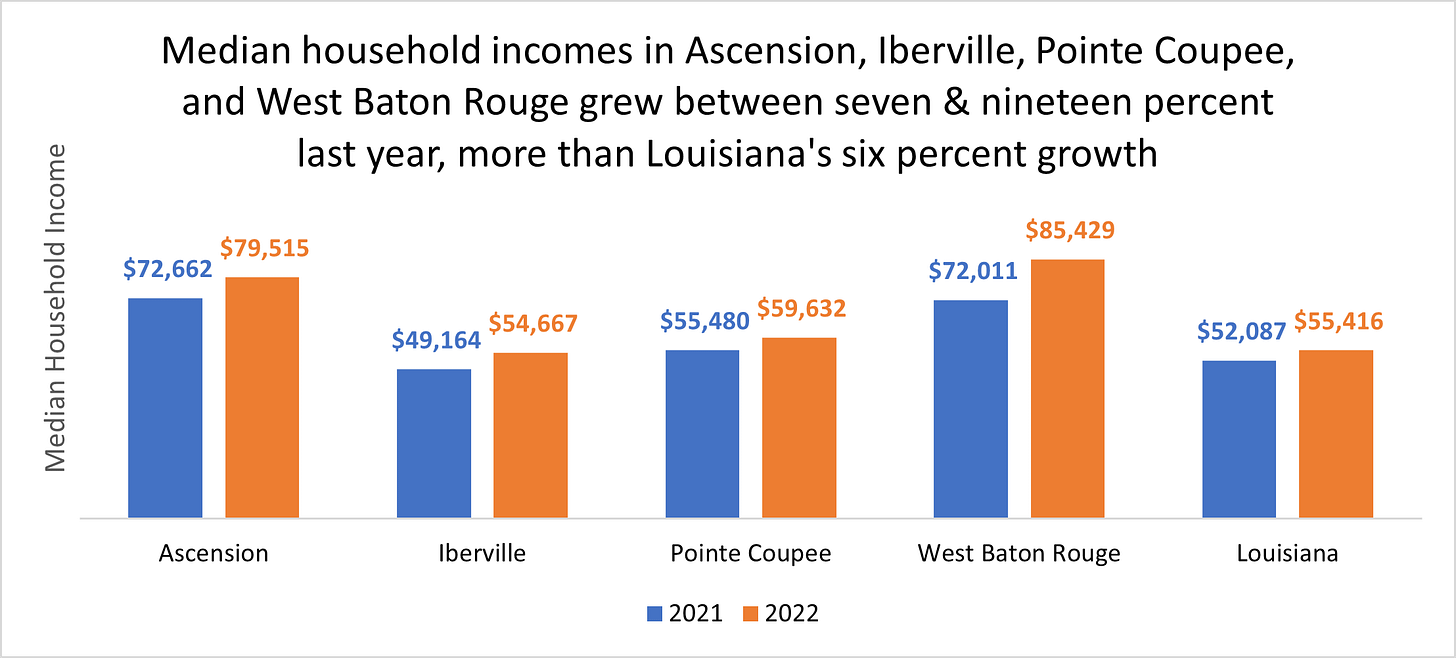Incomes are up & poverty is down in many of the Capital Region's suburban & rural parishes
So what exactly drove this progress?
New data released by the US Census Bureau a few weeks ago shows that good things are happening in some of our region’s suburban and rural parishes, including major poverty reductions and significant household income growth.
Ascension, Iberville, Pointe Coupee, and West Baton Rouge saw big drops in poverty in 2022. The largest net and percentage drop came in West Baton Rouge where the number of people living in poverty was reduced by three-fourths in a single year1.
About sixty percent of parishes in Louisiana saw poverty decline between 2021 & 2022, but three of the five parishes with the largest percentage drop were in the Capital Region2. West Baton Rouge led the state, and Iberville and Pointe Coupee were ranked third and fourth in Louisiana for year-over-year poverty reduction. Combined with Ascension, it appears that more than nine thousand fewer residents of these four parishes were living in poverty in 2022.
When the Census Bureau calculates income for poverty determinations, it includes both earnings from work and cash-based governmental assistance like supplemental security income. Suburban and rural parishes in the Capital Region saw median household incomes grow by anywhere from about $4,100 to about $13,400 between 2021 and 2022, making it unlikely that government assistance was solely responsible for pushing people out of poverty. Plus, many pandemic-era government assistance programs weren’t in effect by 2022. Expanded child tax credits ended late 2021, and the last two stimulus checks were sent out that year as well. Government assistance alone cannot explain why the inflation-adjusted median household income in West Baton Rouge, which saw the region’s strongest growth, jumped 19% to $85,429 in 20223.
So, what caused this income growth and associated drop in poverty? While a lot of factors influence poverty rates, one thing these parishes have in common is a large number of workers employed in the construction sector. As we’ve previously written, employment in construction has bounced back post-COVID which has brought many recently-unemployed construction workers back to work. Broadly, the Baton Rouge Metro ranks first among the nation’s 358 metros for job growth in the construction sector over the last year. Looking at these four parishes specifically, we can tell each of them are home to construction workers at rates above that of the Baton Rouge Metro average.
The graph above shows that, in three of these parishes, residents employed in construction fell after 2019. 2020 is the most recent year for which we can tell where employed workers in an industry live (as opposed to the location of jobs in an industry, which are updated much more regularly). However, we know that these parishes disproportionately house construction workers, and we know that construction employment didn’t rebound to prepandemic levels until late 2022. We also know this work pays well: construction workers in the Capital Region brought in, on average, $1,481 in weekly wages in Q1 of this year, more than government workers and health care professionals. While there are a lot of pieces to the poverty-reduction/income-growth puzzle, booming employment in the construction sector is undoubtedly an important piece.
Zooming out, these data show that Baton Rouge’s suburban and rural parishes are growing incomes and reducing poverty post-COVID.
Source: American Community Survey 1-year supplemental estimates. 2022 Margins of error for the number of people with incomes below the poverty level in these four parishes range from 750 people (West Baton Rouge) to 3,101 (Ascension).
American Community Survey 1-year supplemental tables are only currently available for places with at least 20,000 residents. 60% is based on the forty-five parishes that have at least 20,000 residents.
Source: American Community Survey 1-year supplemental estimates.







